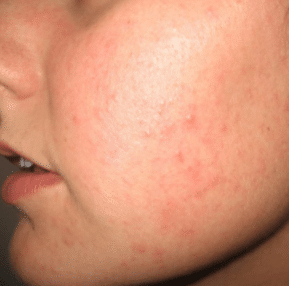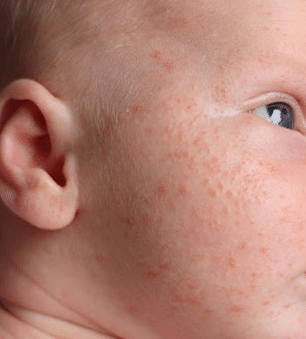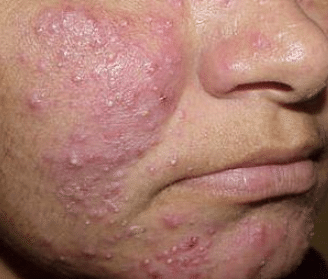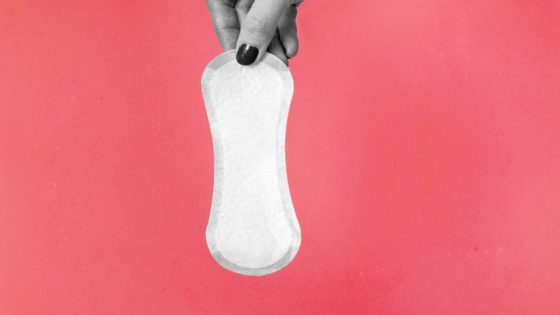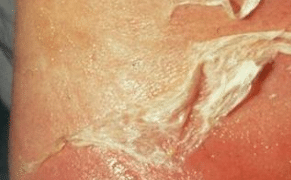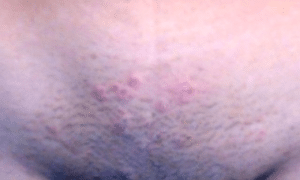Explore on how to get rid of heat rash on face, causes of heat bumps among babies and adults, how long they last, symptoms and prevention measures.
What causes Heat Rash on Face
Dee Anna Glaser, professor of Dermatology at Saint Louis University, School of Medicine in Missouri, explains the causes of Heat Rash on face as below.
Contact Rashes
Contact rashes are a localized allergic reaction of the skin, and are caused by direct contact with variety of substances. This is called contact dermatitis and causes local rash and inflammation only in the area contact where contact has been made. Common causes of contact dermatitis include:
- Rubber, Latex and elastic products
- Detergents, perfumes and cosmetics
- Chemicals in the environment or in clothing
- Certain plants such as poison ivy
- Metal such as zinc, nickel and silver
Prickly Heat is another form of contact rash that caused by wearing tight fitting clothing, or too many layers, which does not allow the skin to breathe. Sunburn or excessive use of artificial sunlamps or sun beds can also cause heat rash. Heat rash that occurs on flexural skin and aggravated by friction is called intertrigo.
Sun-induced Rashes
- Prickly heat known as miliaria develops when sweat glands in the skin get blocked. It may be aggravated by wearing tight fitting clothing, or too many layers, as this does not allow the skin to breathe.
- Sunburn or excessive use of artificial sunlamps or sun beds can also cause a type of heat rash.
- Polymorphic light eruption [PLE], is an immune response to increasing ultraviolet light [UV light exposure. It typically comes on in the spring or while on holiday in sunnier climates.
Allergic Rashes
Allergic rashes [urticaria or urticarial rashes] are caused by excess production of histamines in the body in response to something in your environment or something that you have eaten.
Sometimes these types of rashes occur without any known triggers. These rashes are often called hives, and can anywhere on the body and do not require direct contact with the skin. You may come out in an allergic rash in response to a wide variety of stimuli, including:
- Medication
- Insect or bee stings
- Infectious skin diseases
- Foods especially shellfish and nuts
- Infectious skin disease
Infectious skin Diseases
Several infectious skin diseases also cause a rash. These can be caused by a number of infections with bacteria or viruses, and infestations of mites within the skin. They can easily be passed on by direct contact, including;
- Impetigo
- Molluscum contagiosum
- Scabies
Some infectious skin diseases such as scabies are caused by mites that bore into the skin surface causing irritation and a localized rash. Most infectious skin diseases are common and relatively harmless. Many of them usually only occur in children.
Infectious diseases of the body
There are several diseases of the whole body that include a skin rash as one of their symptoms. These include:
- Shingles
- Meningitis
- Rubella
- Measles
- Chickenpox
Disease based rashes generally appear suddenly, without any obvious trigger, and are usually accompanied by other symptoms such as a fever, lethargy and flu-like symptoms. Rashes caused by infections can often be unbearably itchy.
Chronic Skin Diseases
There are two main chronic skin diseases that cause rashes- eczema and psoriasis. Inflamed rashes and scaly patches can appear anywhere on the body but most often occur around knees and elbows or in patches on the face. The symptoms of chronic skin diseases tend to come and go in flare ups, often in response to external stimuli.
Taking bed rest for too long
Taking prolonged bed rest can also be the reason behind the cause of heat rash. This may elevate to severe level if they are suffering from fever. It is recommended to keep yourself clean to get rid of heat rash.
Immature sweat ducts
Heat rash especially in babies is usually due to immature sweat ducts which get ruptured easily a factor that result to perspiration beneath the skin. Heat rash may also develop if the baby stays in an incubator in the first week after birth. Heat rash can also appear due to wearing of warm clothes or fever.
Physical activities
You can get heat rash due to intense exercises, hard work as well as activities which may cause sweat on the body. There are high chances of the sweaty body get rubbed which in turn causes heat rash.
Overheating
Just like hot and humid atmosphere, overheating may also cause the formation of heat rash on the skin. Dressing warm clothes, sleeping under an electric blanket can also cause the problem of heat rash.
How Long does heat Rash Last
Most cases of heat rash do not require any kind of medication. The rash begins to go away once the skin starts to cool down. Since heat rash is often a temporary condition, within 3 to 5 days, the skin is expected to be completely rash-free already. Most of the heat rashes heal on their own.
Heat Rash on Face Baby
Heat rash in babies is also known as summer rash and it is an eruption of little bumps and sometimes tiny blisters on the skin that shows up when your baby overheats. The bumps may appear red, especially on light skin. Children of all ages can get heat rash, but it’s most common in babies.
If your baby has heat rash, you’ll most likely see it in the folds of his skin and on the parts of his body where his clothing fits snugly, including his chest, stomach, neck, crotch, and buttocks. If he often wears a hat, the rash may spread across his scalp or forehead.
Heat rash develops when your baby sweats so much that her pores clog and sweat can’t get out. Babies and young children are especially prone to heat rash because they have smaller pores than adults. Hot, humid weather is prime time for heat rash, but you might see it in winter if your baby wears too many layers of clothing or running a fever.
Is heat rash serious when it comes to babies? The answer is no, but it’s a sign that your baby is too warm and overheating can lead to serious conditions such as heat exhaustions and heat stroke. Being too warm during sleep can also raise your baby’s risk of SIDS. The heat rash in babies can be painful as well as itchy, and can also be tender to the touch.
To prevent heat rash on baby face according to Dr. Jonathan Bowling, who is a consultant Dermatologist, and prolific health writer, you need to practice the following:
- On a scorching day, you need to keep you baby indoors in air-conditioned space, or look for cool shady or breezy places to sit and play outside. Make sure he is well hydrated by breastfeeding or formula-feeding often.
- Don’t use baby powders- not only can they cause breathing problems and irritate your baby’s lungs but they also block pores and make the skin warmer.
- If it is hot at night, use an air conditioner or a fan in your baby’s room. Direct the fan near the baby but not so that it blowing directly on her. Or place it far away so that only a gentle breeze reaches her.
- Pay attention to areas that tend to get moist, such as the neck, crotch and areas where folds of skin can trap sweat. Wash these areas with cool water and try to keep them as dry as possible.
Symptoms of Heat Rash on Face
According to Huffington post magazine. Heat rashes are not usually accompanied with fever or any other medical symptoms unless there is severe secondary infection on the rashes. The common symptoms of these heat rashes include:
- Small or large red bumps on the skin that might appear close to each other on a particular are of the body.
- Heat rashes can also look like red small blisters in cluster.
- Severe itching, pricking and burning sensation are characteristic symptoms of itchy heat rashes.
- One can easily distinguish prickly heat rashes from other type of skin problems through its patchy and red appearance on the skin along with the characteristic pricking sensation.
- Heat rashes do not go on their own once they appear unless temperature and sweating has come down due to a change in the weather or the rashes has been specifically treated.
- These rashes do not leave any permanent mark on the skin once they are dissipated but if there is injury to the skin due to itching or secondary infection it might cause permanent scaring of the skin.
How to Get Rid of Heat Rash on Face
According to various doctors on Webmd, and Journal of American Academy of Dermatologist , though heat rash causes skin problems, it has not been considered as a severe disorder and unfortunately can be treated with the help of heat rash treatment or home remedies to treat the problem. Below are 7 major home remedies for faster treatment as discussed in the Journal:
- OATMEAL
It is a famous treatment for countering prickly heat rash as it is filled with anti-irritating, anti-inflammatory as well as soothing properties. Along with providing a soothing effect on skin, it also helps in providing instant relief from the inflammation as well as heat rash itching.
- Mix a cup of oatmeal powder in the bathtub and stir it well till it gets the milky color.
- Soak yourself in the bath for around 20 to 30 minutes.
- Now pat yourself dry with the help of a soft towel.
- Repeat this process twice a week to get relief from prickly heat.
- COLD COMPRESS
You can get instant relief from the inflammation as well as prickling sensation and itching by applying a cold compress on the affected area.
- Dip a clean cloth in cold water
- Wring the excess water out.
- Place the cloth onto the affected area for around 20 minutes.
- Repeat the process around 3 to 5 times a day for a week.
- Instead, you can also use ice cubes on the cloth, apply the ice packs on the affected area for at least 20 minutes.
- If they are both not good for you, try to get the cold shower to reduce the pain as well as itching caused due to the symptom of heat or prickly rash.
- BAKING SODA
Baking soda works as a gentle exfoliating agent and provides a better treatment for heat rash. It also works well in unclogging the skin pores as well as removing all the dirt and impurities. This is helpful in removing all the inflammation as well as itching linked to the symptoms of heat rash.
- In a cup of water add a teaspoon of baking soda.
- Take a clean cloth and dip it into the mixture.
- Take it out and wring the excess water out.
- Place the cloth on the affected area for around ten minutes.
- Repeat this process for 3 to 5 times in a day for a period of a week.
- SANDALWOOD POWDER
Sandalwood also helps in providing a soothing effect and helps in eliminating the symptoms of heat rash. It also triggers the fast recovery by helping in cooling down the body temperature.
- Mix sandalwood powder and rose water into each other in equal amounts.
- Apply the paste on the affected area and leave it till it gets dry.
- Follow this process for two times every week.
- You can also use coriander powder in sandalwood powder and rose water mixture.
- Also, sprinkle some sandalwood powder as a talcum on the affected area.
- HENNA POWDER
Henna is used in the Middle East and South East Asian countries for decorating the hands; this herb is known to treat skin ailments. It is a cooling agent and also an astringent while possessing antibacterial properties. If you do not mind a reddish tinge on your skin, you can use this home remedy for prickly heat rash.
- Make a thick paste of henna powder using some water.
- Apply it on your rash.
- Leave it for about 20 minutes before rinsing it off.
- A single application of this remedy will have lasting results.
- CHICKPEA FLOUR
Chickpea is also called gram flour, chickpea flour pack acts as a cleaner for skin. It removes the impurities that are clogging the pores and also exfoliate the dead skin cells. This home remedy will provide relief from the itching and prickling sensation.
- Make a thick paste of chickpea flour using some distilled water.
- Apply the paste on to the affected part and let it stand for about 20 minutes
- Use cool water to wash off the paste.
- Apply this pack twice every day.
- CUCUMBER
One of the most disturbing aspects of heat rash is the burning sensation. You can ease it by applying cucumber on your skin as it instantly soothes the skin and provides a cooling effect.
- Peel the cucumber and cut long and thin slices.
- Cool these in the fridge for a couple of minutes and then place them on the rashes until they come back to room temperature.
- Repeat this if required.
- Apply cucumber slices every day on your prickly heat rashes.
How to Treat Heat Rash on Face
Below are 7 ways on How to treat heat rash on face highlighted as home remedies by Journal of Clinical and Investigative Dermatology
- CAMPHOR
This is a very effective home remedy for treating heat rash; it heals a burning sensation and itching. The skin will feel cool and refreshing when applied to the hear rash. Neem being antimicrobial in nature will prevent any infections from developing at the affected site.
- Take a mallet and crush the camphor into powder.
- Mix a little neem oil in the powder to make a gooey paste.
- Apply the paste on your skin and let it sit for 5-7 minutes.
- Rinse it off with water.
- Repeat this every alternate day.
- TALCUM POWDER
Talcum powder can also be used to hasten the healing process. Opt for a herbal Talcum powder. It will help your skin dry in the hot, humid conditions and this, in turn, helps to heal the rashes quickly. Be sure not to use scented talcum powder, as it can irritate your skin even further.
- After taking a shower, pat your skin dry and sprinkle some talcum powder on the prickly heat rashes. Do this every morning and every night.
- EPSOM SALT
Epsom salt draws out toxins from the body and also exfoliates dead calls. This unclogs the pores and helps heal the heat rashes:
- Draw a warm water bath with Epsom salt.
- Soak in this for about 20 minutes.
- You can also apply soft cloth soaked Epsom salt water on the rashes, in case you do not have the facility to draw a bath.
- APPLE CIDER VINEGAR
Apple cider vinegar balances the skin’s PH while reducing the itching and irritation with its anti-inflammatory compounds.
- Dilute the Apple Cider Vinegar with water and soak the cotton ball in this solution.
- Apply this solution using the cotton to the affected area.
- Let it dry naturally.
- Wash it off after 20 minutes.
- Repeat this once every day.
- FULLER’S EARTH
Fuller’s Earth has long been used for treating prickly heat. It is excellent in unclogging pores and giving the skin a fresh feeling.
- Take the fuller’s earth and mix it with a few drops of rose water to make a paste.
- Apply the paste on the affected areas and wash off with cold water after about 20 minutes.
- Apply this pack every day initially and then every alternate day until the prickly heat is completely gone.
- APPLY GINGER
Ginger has long been used in Asian culture for its medicinal properties. It also can help ease the itching and stinging sensation caused by prickly heat.
- Grate some fresh ginger root and boil it in water.
- Let the water cool and then use a clean, soft washcloth to dab your skin with this solution.
- Keep the solution on for ten to 20 minutes and then rinse it off.
- You can repeat this twice a day.
- WATERMELON
The coolness of the fruit soothes and refreshes the irritated skin. Watermelon also contains antioxidants that exert anti-aging effects on the skin.
- Take some watermelon, de-seed it and make a pulp.
- Apply the pulp on your heat rash and let it sit for 30 minutes.
- Wash off with distilled water.
- Repeat this 3 times a day until the heat goes away.
- Alternatively, you can gulp down a glass of crushed watermelon to heal from within by hydrating your skin.
Further references:
- Remedies for heat rash stylecraze.com/articles/effective-home-remedies-for-prickly-heat/
- Heat Rah https://www.medicinenet.com/heat-rash/article/article.htm
- Prickly Heat https://www.nhs.uk/conditions/heat-rash-prickly-heat/
- Causes of heat rash https://www.onhealth.com/content/1/heat_rash


